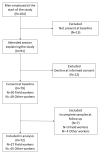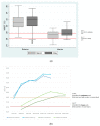Kidney Function in Rice Workers Exposed to Heat and Dehydration in Costa Rica
- PMID: 35564355
- PMCID: PMC9100597
- DOI: 10.3390/ijerph19094962
Kidney Function in Rice Workers Exposed to Heat and Dehydration in Costa Rica
Abstract
The aim of this study was to evaluate heat exposure, dehydration, and kidney function in rice workers over the course of three months, in Guanacaste, Costa Rica. We collected biological and questionnaire data across a three-month-period in male field (n = 27) and other (n = 45) workers from a rice company where chronic kidney disease of unknown origin (CKDu) is endemic. We used stepwise forward regression to determine variables associated with estimated glomerular filtration rate eGFR at enrollment and/or change in eGFR, and Poisson regression to assess associations with incident kidney injury (IKI) over the course of three months. Participants were 20−62 years old (median = 40 in both groups). Dehydration was common (≥37%) in both groups, particularly among other workers at enrollment, but field workers were more exposed to heat and had higher workloads. Low eGFR (<60 mL/min/1.73 m2) was more prevalent in field workers at enrollment (19% vs. 4%) and follow-up (26% vs. 7%). Field workers experienced incident kidney injury (IKI) more frequently than other workers: 26% versus 2%, respectively. Age (β = −0.71, 95%CI: −1.1, −0.4), current position as a field worker (β = −2.75, 95%CI: −6.49, 0.99) and past work in construction (β = 3.8, 95%CI: −0.1, 7.6) were included in the multivariate regression model to explain eGFR at enrollment. The multivariate regression model for decreased in eGFR over three month included current field worker (β = −3.9, 95%CI: −8.2, 0.4), current smoking (β= −6.2, 95%CI: −13.7−1.3), dehydration (USG ≥ 1.025) at both visits (β= −3.19, 95%CI: −7.6, 1.2) and pain medication at follow-up (β= −3.2, 95%CI: −8.2, 1.95). Current fieldwork [IR (incidence rate) = 2.2, 95%CI 1.1, 5.8) and being diabetic (IR = 1.8, 95%CI 0.9, 3.6) were associated with IKI. Low eGFR was common in field workers from a rice company in Guanacaste, and being a field worker was a risk factor for IKI, consistent with the hypothesis that occupational heat exposure is a critical risk factor for CKDu in Mesoamerica.
Keywords: agricultural workers; chronic kidney disease; heat exposure; hydration; occupational.
Conflict of interest statement
The authors declare no conflict of interest.
Figures


Similar articles
-
Biomarkers of Kidney Injury Among Nicaraguan Sugarcane Workers.Am J Kidney Dis. 2016 Feb;67(2):209-17. doi: 10.1053/j.ajkd.2015.08.022. Epub 2015 Oct 9. Am J Kidney Dis. 2016. PMID: 26454687 Free PMC article.
-
Heat stress, hydration and uric acid: a cross-sectional study in workers of three occupations in a hotspot of Mesoamerican nephropathy in Nicaragua.BMJ Open. 2016 Dec 8;6(12):e011034. doi: 10.1136/bmjopen-2016-011034. BMJ Open. 2016. PMID: 27932336 Free PMC article.
-
Occupational heat exposure and its impact on kidney health among cashew workers.J Nephrol. 2024 Sep;37(7):2007-2016. doi: 10.1007/s40620-024-02022-6. Epub 2024 Jul 27. J Nephrol. 2024. PMID: 39068375
-
Chronic Kidney Disease Among Workers: A Review of the Literature.Workplace Health Saf. 2019 Sep;67(9):481-490. doi: 10.1177/2165079919843308. Epub 2019 Jun 10. Workplace Health Saf. 2019. PMID: 31179873 Review.
-
Leptospirosis Renal Disease: Emerging Culprit of Chronic Kidney Disease Unknown Etiology.Nephron. 2018;138(2):129-136. doi: 10.1159/000480691. Epub 2017 Sep 20. Nephron. 2018. PMID: 28926845 Review.
Cited by
-
Molecular Challenges and Opportunities in Climate Change-Induced Kidney Diseases.Biomolecules. 2024 Feb 21;14(3):251. doi: 10.3390/biom14030251. Biomolecules. 2024. PMID: 38540672 Free PMC article. Review.
-
Where do you live and what do you do? Two questions that might impact your kidney health.Front Nephrol. 2022 Oct 5;2:1011964. doi: 10.3389/fneph.2022.1011964. eCollection 2022. Front Nephrol. 2022. PMID: 37675017 Free PMC article. Review.
-
Sex-Specific Association of Ambient Temperature With Urine Biomarkers in Southwest Coastal Bangladesh.Kidney Int Rep. 2024 Mar 11;9(6):1860-1875. doi: 10.1016/j.ekir.2024.03.002. eCollection 2024 Jun. Kidney Int Rep. 2024. PMID: 38899224 Free PMC article.
-
Heat and health of occupational workers: a short summary of literature.J Occup Health. 2024 Jan 4;66(1):uiae018. doi: 10.1093/joccuh/uiae018. J Occup Health. 2024. PMID: 38604180 Free PMC article. Review.
-
Heat-induced kidney disease: Understanding the impact.J Intern Med. 2025 Jan;297(1):101-112. doi: 10.1111/joim.20037. Epub 2024 Nov 28. J Intern Med. 2025. PMID: 39607397 Free PMC article. Review.
References
-
- Wegman D., Crowe J., Hogstedt C., Jakobsson K., Wesseling C., editors. Report from the Second International Research Workshop on Mesoamerican Nephropathy. SALTRA/IRET-UNA; Heredia, Costa Rica: 2016. [(accessed on 13 February 2022)]. p. 193. Available online: http://www.regionalnephropathy.org/wp-content/uploads/2016/08/MeN-2015-S....
-
- Wesseling C., de Joode B.V.W., Crowe J., Rittner R., Sanati N.A., Hogstedt C., Jakobsson K. Mesoamerican nephropathy: Geographical distribution and time trends of chronic kidney disease mortality between 1970 and 2012 in Costa Rica. Occup. Environ. Med. 2015;72:714–721. doi: 10.1136/oemed-2014-102799. - DOI - PubMed
Publication types
MeSH terms
LinkOut - more resources
Full Text Sources
Medical
Research Materials
Miscellaneous

